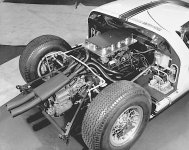The old saying holds true "there is No Replacement for Displacement" as others have said its not the HP its the TQ - Torque moves the mass - HP just keeps it moving
Forget looking at the MAX HP and TQ numbers - look at the "power under the curve" the usable TQ and HP numbers (the Dyno graph) they will tell the story how they perform
I agree with
@tjZ06 on LS7 heads -but I think the crate engines and lower redlines fixed that issue. But the potential for HP in the Future (you will always tire of how much you have) is greater with more CU and quite frankly the "parts" in the LS7 are just better from the Block up - the LS3 block is no way as robust and the LS7 is made to be abused - the Rods are better material, the pistons are better material.
The downside of the LS7 Crate is that the cam is a little too aggressive for cruising the dunes unless you have a slightly lower gear ration unlike the Corvette version its low speed manners are a bit rough
Do Not believe anything you hear abut the dry sump being needed - of course a race inspired Dry sump (aftermarket) is always better to handle off camber duning - but it was done for ground clearance, massive side load G's in turns and just balance in the corvette
IMO you will be satisfied with either. I have done the connect and cruise version of the LS376 in a street car. For the money it was a good runner.
However all that being said - knowing what I know about having put crate engines in sand cars and the money spent modifying them for the best outcome, If I was going for new build for a sand car I would spend a bit more and get a specialized build with all forged internals, the right cam and head combo so the power is usable where you need it most in the dunes, a drive by cable throttle - I hate DBW in the sand personally even with pedal commanders and that non sense, some better fuel rails for a clean look and ease of setup, an F body front drive set, and an F body oil pan set up.
That is a much better overall experience for the sand IMO




